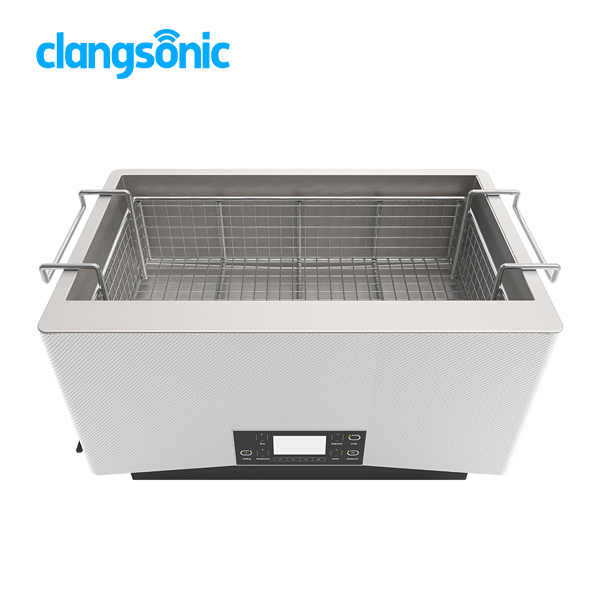The Secret to Spotless Precision: Discovering the Power of Tabletop Ultrasonic Cleaners
2025-03-13
In today’s fast-paced world, maintaining cleanliness and precision is more important than ever, especially in industries where even the smallest impurity can compromise quality. Whether you’re a watchmaker, dentist, or electronics technician, a tabletop ultrasonic cleaner is a game-changing tool that can transform the way you approach cleaning delicate items. But what exactly is a tabletop ultrasonic cleaner, and why is it becoming such an essential device in professional and personal settings? Let’s dive into its functionality, benefits, and why it might just be the solution you’ve been searching for.
What is a Tabletop Ultrasonic Cleaner?
A tabletop ultrasonic cleaner is a compact and efficient cleaning device that uses high-frequency sound waves (ultrasound) to clean various objects. It works by generating ultrasonic waves through a liquid solution, creating millions of microscopic bubbles that implode upon contact with the surface of the object being cleaned. This process, known as cavitation, produces high levels of energy that effectively dislodge dirt, oil, grime, and other contaminants from surfaces, even in the tightest and most intricate spaces.
These cleaners are popular for their ability to clean items without causing damage, making them ideal for delicate or precision-based industries. Unlike traditional cleaning methods that may involve harsh chemicals or abrasive techniques, ultrasonic cleaners provide a gentler yet highly effective solution.
How Does a Tabletop Ultrasonic Cleaner Work?
At the core of any ultrasonic cleaning system lies the concept of cavitation. Here’s a breakdown of how it works:
1. The Cleaning Solution
The cleaner is filled with a special liquid solution—often water mixed with a cleaning detergent or solvent. This solution plays a key role in helping to break down contaminants.
2. Ultrasonic Transducer
The device houses an ultrasonic transducer, which converts electrical energy into high-frequency sound waves. These waves generate pressure waves in the liquid, causing the microscopic bubbles (cavitation bubbles) to form.
3. Cavitation Effect
As the bubbles rapidly expand and collapse, they create powerful cleaning action. The implosion of these bubbles generates intense localized energy, which helps to lift dirt and particles from surfaces, even from complex, hard-to-reach areas like crevices, grooves, and joints.
4. Cleaning Process
Once the ultrasonic waves and cavitation bubbles interact with the object, contaminants are loosened and washed away. After a few minutes, the object is thoroughly cleaned and ready to be rinsed and dried.
Benefits of Tabletop Ultrasonic Cleaners
1. Deep Cleaning of Delicate Items
Ultrasonic cleaning is perfect for cleaning delicate items that could be damaged by traditional cleaning methods. Fine jewelry, medical instruments, and electronic components can all benefit from the gentle yet thorough cleaning action of ultrasonic waves. For example, ultrasonic cleaners are frequently used to clean watches, glasses, dental tools, and electronics—all of which often have intricate parts that are difficult to clean manually.
2. Efficiency and Speed
Compared to manual cleaning methods, ultrasonic cleaners significantly reduce cleaning time. What might take hours of scrubbing or chemical cleaning can be done in minutes with a tabletop ultrasonic cleaner. The cavitation effect allows the cleaner to reach places that would be almost impossible with manual scrubbing, saving time and labor costs.
3. No Scratches or Damage
Ultrasonic cleaning is a non-abrasive process, meaning that even delicate items such as jewelry with gemstones or intricate watch parts won’t get scratched or damaged. The sound waves are gentle yet powerful enough to dislodge dirt and grime, making it ideal for sensitive materials like gold, silver, and platinum, as well as plastic, glass, and ceramics.
4. Environmentally Friendly
Unlike chemical-based cleaning methods that can use harsh, potentially toxic cleaners, ultrasonic cleaning uses a simple liquid solution, which can often be recycled and reused. This makes it a more environmentally friendly option for businesses looking to reduce waste and chemical use in their cleaning processes.
5. Versatility
Tabletop ultrasonic cleaners are incredibly versatile, making them useful in a wide range of industries. Whether you’re working in healthcare, automotive, electronics, or pharmaceuticals, these devices are adaptable to various cleaning needs. They can clean everything from precision medical instruments to mechanical parts and small machinery.
Applications of Tabletop Ultrasonic Cleaners
Ultrasonic cleaners are used in a variety of industries and applications, including:
1. Jewelry Industry
Jewelers often use ultrasonic cleaners to clean delicate and intricate pieces of jewelry, including rings, necklaces, and bracelets. The device gently removes dirt, oil, and polishing compounds, ensuring the jewelry maintains its shine without damage.
2. Dental and Medical Fields
Dental professionals rely on ultrasonic cleaners to sterilize tools and equipment with minimal risk of damage. The ultrasonic waves can thoroughly clean instruments like dental probes, scalers, and handpieces, providing effective disinfection while preserving their delicate parts.
3. Electronics and Precision Equipment
From circuit boards to camera lenses, ultrasonic cleaners can be used to clean delicate electronic components. The technology is ideal for removing dust, grease, and other contaminants from the tiny, hard-to-reach areas of electronic devices, such as smartphones, cameras, and computer parts.
4. Automotive Industry
In the automotive industry, ultrasonic cleaners are used to clean engine parts, carburetors, fuel injectors, and other small mechanical components. This ensures that parts are free from contaminants that could affect performance and longevity.
5. Optical and Camera Equipment
Opticians and photographers use ultrasonic cleaners to maintain the cleanliness of their lenses and other optical equipment. The ultrasonic waves provide a deep clean that prevents scratches and ensures optical clarity.
How to Choose the Right Tabletop Ultrasonic Cleaner
When shopping for a tabletop ultrasonic cleaner, there are a few factors to consider:
- Size and Capacity: Choose a cleaner that is the right size for your items. Larger machines can handle bulkier parts, while smaller models are ideal for delicate items like jewelry or small medical instruments.
- Frequency: The frequency of the ultrasonic waves can affect cleaning efficiency. Higher frequencies are typically used for smaller, more delicate items, while lower frequencies are better for heavy-duty cleaning.
- Timer and Temperature Controls: Some ultrasonic cleaners come with adjustable timers and temperature controls to optimize the cleaning process based on the items being cleaned.
- Build Quality: A high-quality, durable ultrasonic cleaner is essential for long-term use, especially for heavy-duty applications.
Conclusion
Tabletop ultrasonic cleaners represent a technological breakthrough in cleaning, offering unmatched precision, efficiency, and versatility. From cleaning delicate jewelry to maintaining medical equipment and electronics, ultrasonic cleaners deliver a level of deep cleaning that manual methods simply can’t match. Whether you're in a professional setting or looking for a solution for personal use, these machines are a worthy investment for anyone looking to achieve spotless results with minimal effort.
By harnessing the power of sound waves, a tabletop ultrasonic cleaner ensures your items are cleaned thoroughly, gently, and quickly—providing you with more time to focus on what really matters.



